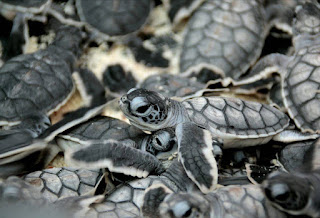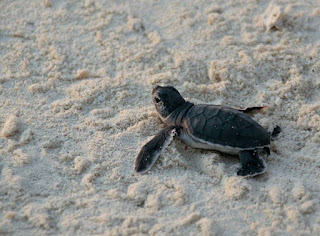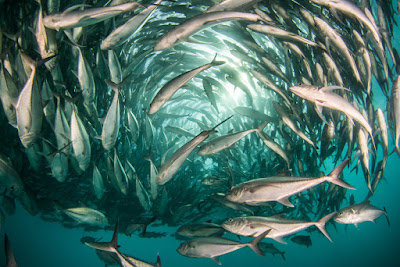Download the roadmap as a PDF -->
here<--
Show your support -->
here<--
A
Roadmap To Develop A Second Sipadan
The
role of Micro Marine Protected Areas as a step towards development of
the Semporna Barrier Reef Marine Conservation area
Sipadan
has unique geography and location.
BUT
the sharks, turtles, fish and other biodiversity can occur in other
places.
With
this roadmap, Sabah could have many areas with as much tourism
potential as Sipadan.
This
project document describes practical steps and actions from many
organisations and individuals to help develop sustainable ecotourism
and rebuild a healthy ecosystem with reef sharks and breeding fish
stocks in the Semporna District. This is a discussion document,
please email Info@tracc-borneo.org
with information, sightings, suggestions, improvements
Roadmap 2
Step 11 Sites for
Micro MPA 6
Appendix I Site
characteristics and choices 8
Appendix 2
Monitoring & further work 9
Roadmap
Step
1 The economics
Tourists
come to Sipadan to be wowed by amazing fish, sharks and turtles. All
tour operators compete for Sipadan permits.
More
permits or alternative great dive sites would enable the industry to
expand.
Step
2 Why is Sipadan unique?
Primarily
because it has been protected and the fish, coral and shark
populations are healthy.
There are beautiful
reefs in many places around Semporna, but Sipadan has more big fish
and the only abundant sharks. This is not Sipadan!
Step
3 What do visitors want to see?
Primary
attraction is sharks. The bigger the better. Plus turtles and charismatic big fish such as the humphead wrasse.
 |
| Black tip reef sharks populations can recover BUT only if we stop eating them! |
Step
4 What works
Langkayan
island in SIMCA is a totally protected area North of Sandakan and has
shown that reef recovery is possible. To expand diving tourism and
create a 2nd Sipadan we need multiple additional areas
where shark populations can recover without conflict with existing
villagers.
Step
5 What works for ecotourism
In
Sabah with many artisanal fishers, only areas with 100% no fishing
can create world class ecotourism sites. Small sites with total
protection are better than bigger sites with only partial protection.
Step
6 The best protection is ownership
Artificial reefs like
this have been built by resorts to attract marine life.
Resorts which
are responsible for their own reefs are the best environmental
wardens. Many resorts in Semporna have invested money in rebuilding
reefs for their guests. At the moment these underwater structures
are not legally protected.
Step
7 Learn from Forests
The
simplest solution to avoid conflict with local residents in the
development of Marine Protected Areas (MPA's) is to learn from the
terrestrial parks in Sabah:- Mount Kinabalu, Maliau Basin and Danum
Valley were chosen because there were few or no people to create
conflict as well as for the amazing biodiversity.
Step
8 What works for enforcement
Small
protected areas close to ecotourism centres are the easiest to
enforce. The house reef from each resort can become a small MPA with
enforcement by Honorary Wildlife wardens.
The Darvel Bay reefs
are too difficult to patrol and get limited visitors. The NE
Semporna Islands, (Mataking, Pandanan, Timba Timba and Pom Pom
Island) and the Roach reefs have no village and few fishermen. Mabul and Ligitan have
big village communities with many fishermen.
Step
9 Aggregation sites need special protection.
Sites
with large populations of fish, sharks, turtles or rays need a
localised MPA with regular enforcement and patrols.
Sri
Amil/Ligitan has unique, WORLD CLASS schools of Mobula Rays, These
need focused conservation efforts.
Pom
Pom Island has a small population of severely endangered Humphead
wrasse.
Pom
Pom Island, Mataking, Pandanan, Timba Timba have large populations
of Turtles using the seagrass beds.
 |
Bumphead parrotfish are a major attraction on Sipadan BUT
are eaten everywhere else |
Step
10 Awareness of existing regulations
Proposed
Protection for Endangered Marine life in Semporna
Location
|
Species
|
Action
|
Conservation
status
|
Complete
district
|
Turtles
|
No
hunting/harvest
(National & CITES protection)
|
Critically
endangered
|
Complete
district
|
Giant clams
(Tridacna & Hippopus Spp)
|
No
hunting/harvest
(State wide protection)
|
Vulnerable
(some species very rare)
|
Complete
district
|
Whale shark
|
No
hunting/harvest
(National & CITES protection)
|
Vulnerable
|
Complete
district
|
Humphead
wrasse
|
No
hunting/harvest
(CITES protection)
|
Endangered
|
Complete
district
|
Bumphead
parrotfish
|
No
hunting/harvest
(CITES protection)
|
Vulnerable
|
Complete
district
|
Manta &
Mobula Rays
|
No
hunting/harvest
(CITES protection)
|
Threatened to
regionally extinct
|
Complete
district
|
Sharks
|
No targeted
fishing. Bycatch by commercial fishing monitored & regulated
|
Threatened to
regionally extinct
|
These
are works in progress, please email with suggestions to
Info@tracc-borneo.org
Aggregation
sites for Mobula rays are a National treasure and should be totally
protected.
Step 11 Sites
for Micro MPA
Proposed
Micro MPA for Endangered Marine life in Semporna
Location
|
Species
|
MPA size
|
Enforcement
|
Roach reef
|
Black tip reef
sharks
Coral reefs
|
500m long X
250m offshore from reef edge
|
Easy
|
Kapalai
|
Coral reefs
|
500m long X
250m offshore from reef edge
|
Limited
conflicts
|
Mataking
|
Turtles, Big
eye trevally, Barracuda
Coral reefs
|
West side of
Mataking Besar X 250m offshore from reef edge
|
Easy
|
Pandanan
|
Turtles,
Bumphead parrotfish
Coral reefs
|
1500m long X
250m offshore from reef edge
|
Easy
|
Pom Pom
|
Turtles,
Sharks, Humphead wrasse, Bumphead parrotfish
Barracuda, Coral
reefs
|
West side of
Pom Pom X 250m offshore from reef edge
|
Easy
|
Timba Timba
|
Turtles,
Bumphead parrotfish
Coral reefs
|
??
|
Village
conflicts
|
Mabul
|
Coral reefs
|
?? Possibly
Paradise 1 to SWV
|
Village
conflicts
|
Seaventures
Oil rig
|
Coral reefs
|
250m circle?
|
Village
conflicts
|
These
are works in progress, please email with suggestions to
Info@tracc-borneo.org
Schools of jacks give
photo opportunities at many locations. These are at Mataking island
but there is no protection in Sabah for tourist attractions.
Step
12 Benefits
12a
Environmental Benefits
These
proposed Micro MPA will increase biodiversity and allow broodstock
fish to develop and breed. The larvae from fish and other species
will populate many reefs all over the region. The sites which have no
villages will also protect a large number of endangered Turtles.
The public awareness program can also show villagers the destruction caused by blast fishing and the reef restoration effort needed to regrow reefs.
12b
Economic benefits
For
very little economic cost, the Semporna district will have a series
of improved dive and snorkel sites that will help grow the numbers of
tourists visiting. Protecting sharks and rays makes the most sense,
A UMS study showed that dead sharks are worth RM5 million to Sabah
while live sharks are worth RM200 million.
 |
This pile of sharks is worth less than $100 US.
Every diver to sabah would pay an additional $100 to be able to dive with sharks!! |
12c
Relative benefits
The
proposed Micro MPA are a very small proportion of the reef area in
Semporna. These areas are very small for healthy big fish
populations and tiny for shark areas but they represent a goal which
could be achieved.
12d
Benefits for nearby communities
MPA
in other areas have shown that if 20% of a reef is protected then
there are increased benefits to the other 80% of the reef because of
export of adult and juvenile fish. The locations suggested as
primary sites for Micro MPA are all chosen because there is no local
village.
12e
Equitable benefits
This
proposal does not address the multiple user issues on islands with
large local villages. Mabul. Kalapuan, Dinawan etc will each need
community consultations to achieve different solutions.
Step
13 Administration
Administration
of the Semporna Barrier reef Marine Protected Areas will need to be
shared between the Private sector (Resorts, Hotels etc), the
Government (District office, Wildlife Dept.) and NGO's (WWF, TRACC,
Green Semporna Etc)
Appendix I Site
characteristics and choices
Endangered
Species Sites Comparisons
|
Turtles
|
Humphead
Wrasse
|
Bumphead
Parrotfish
|
Giant
clams
|
Sipadan
|
Abundant
|
Common
|
Few
|
Common
|
Roach
reef
|
Rare
??
|
Rare
??
|
Rare
??
|
??
|
Kapalai
|
Rare
|
Rare
|
Rare
|
Rare
|
Ligitan/Sri
Amil
|
??
|
??
|
??
|
??
|
Mataking
|
Abundant
|
Rare
|
Rare
|
Rare
|
Pom
Pom Island
|
Abundant
|
Common
|
Common
|
Common
|
Pandanan
|
Abundant
|
Rare
|
Rare
|
Rare
|
Other
sites
|
Few
|
None
|
None
|
occasional
|
|
|
|
|
|
These
are works in progress, please email with suggestions to
Info@tracc-borneo.org
Reef
Shark Sites Comparisons
|
Grey
reef
shark
|
White
tip
reef shark
|
Black
tip
reef shark
|
Coral
Cat
sharks
|
Sipadan
|
Few
|
Abundant
|
Few
|
Rarely
seen
|
Roach
reef
|
??
|
??
|
Common
|
??
|
Ligitan
|
??
|
??
|
??
|
??
|
Pom
Pom Island
|
Rare
|
None
|
None
|
Common
|
Other
sites
|
None
|
None
|
None
|
occasional
|
These
are works in progress, please email with suggestions to
Info@tracc-borneo.org
Appendix 2
Monitoring & further work
The
monitoring tasks will change as the reefs start to recover but the
following is a summary of the scope of work required to create a
Marine Protected Area. Much of this information is available.
Biodiversity
surveys to identify what species are present in the area.
-
GIS
based Habitat survey to map the resources and identify where they
are.
-
Identify
priority areas and tasks for conservation.
-
Baseline
surveys using standardised techniques for monitoring of critical
near shore habitats, including mangrove, sea grass and reef
communities.
-
Development
of a management plan.
-
Conduct
surveys for Sharks, Turtles, Sea Birds, giant clams, sea cucumber,
Fish & Coral
-
-
-
Clear
the beaches of debris to encourage turtle nesting.
-
Monitor
and record all instances of nesting and egg laying, turtles, birds,
fish, coral etc.
-
Liase
with the Wildlife dept. to remove introduced species such as cats to
encourage the return of the sea bird populations.
-
Work
with Wildlife, UMS, Fisheries and others to determine which rare
species have been
removed
from the island and determine if re-introductions of rare species is
appropriate.
-
Improve
awareness of the rich biodiversity within the MPA by taking photos,
video and publishing these.
-
Write
regular Internet, Blog, newspaper and magazine articles
-
Liase
with ESSCOM, PGA and wildlife rangers to monitor violations of the
MPA.
-
Conduct
regular assessments of the effectiveness of the marine protected
area.
-
Work
with academic institutions to host Train the Trainers courses for
future teachers, lecturers and academic mentors.
-
Mentor
all volunteers, students and visitors to be environmental
ambassadors for marine conservation.


















